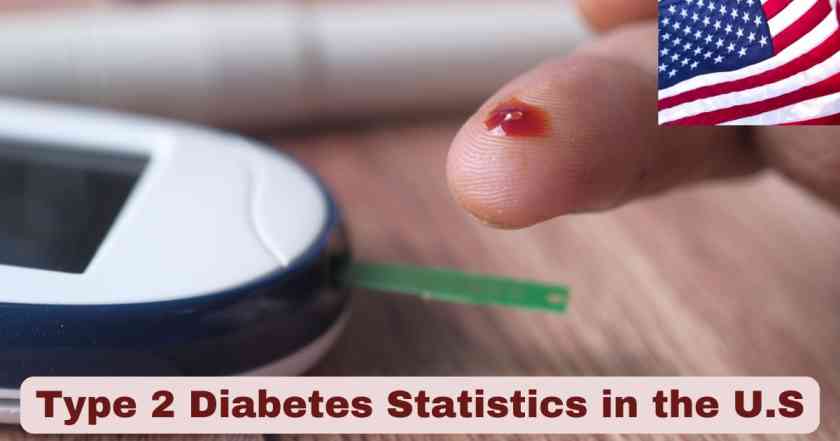Type 2 Diabetes in the U.S. in 2025
The landscape of type 2 diabetes in America has reached unprecedented levels, with millions of Americans battling this chronic condition that fundamentally alters how the body processes blood sugar. Type 2 diabetes primarily affects adults and accounts for approximately 90-95% of all diabetes cases in the United States. This condition occurs when the body becomes resistant to insulin or when the pancreas fails to produce sufficient insulin to maintain normal blood glucose levels.
The current state of type 2 diabetes in the United States represents one of the most significant public health challenges of our time. The condition disproportionately affects certain demographic groups and continues to impose substantial economic burdens on individuals, families, and the healthcare system. With millions of Americans currently living with type 2 diabetes and millions more at risk, understanding the latest statistics and trends has become crucial for healthcare professionals, policymakers, and individuals seeking to make informed decisions about their health and wellness.
Type 2 Diabetes Facts in the U.S. 2025
| Type 2 Diabetes Fact | Statistic | Source |
|---|---|---|
| Physician office visits for type 2 diabetes | 38.2 million visits annually | CDC 2019 |
| Emergency department visits for type 2 diabetes | 579,000 visits annually | CDC 2021 |
| Type 2 diabetes as primary diagnosis | 14.2% of all physician visits | CDC 2019 |
| Economic burden of type 2 diabetes | 90-95% of total $412.9 billion diabetes cost | ADA 2022 |
| Prediabetes cases (future type 2 risk) | 97.6 million adults (1 in 3 adults) | NIDDK 2021 |
| Men vs women prediabetes rate | 41% men vs 32% women | CDC 2017-2020 |
| Future type 2 diabetes from gestational | 50% of gestational diabetes cases | NIDDK |
| Type 2 diabetes prevention potential | Up to 70% of prediabetes cases preventable | CDC |
The statistics presented in this comprehensive table reveal the staggering scope of type 2 diabetes across American society. The fact that 38.2 million physician office visits annually are specifically for type 2 diabetes demonstrates how this single condition dominates healthcare utilization in the United States. Most concerning is that type 2 diabetes accounts for 14.2% of all physician visits, making it one of the most common reasons Americans seek medical care and highlighting the chronic nature of this condition that requires ongoing management.
The 579,000 emergency department visits for type 2 diabetes represent the more serious complications of this condition, often involving diabetic ketoacidosis, severe hypoglycemia, or diabetes-related complications such as diabetic foot ulcers and infections. The economic implications are staggering, with type 2 diabetes accounting for 90-95% of the total $412.9 billion annual diabetes-related healthcare costs. Perhaps most significant is the 97.6 million Americans with prediabetes, as this represents a massive population at high risk for developing type 2 diabetes within the next decade if preventive measures are not implemented.
Type 2 Diabetes Healthcare Utilization in the U.S. 2025
| Healthcare Setting | Type 2 Diabetes Visits | Percentage | Clinical Impact |
|---|---|---|---|
| Physician office visits | 38.2 million | 14.2% of all visits | Primary diagnosis |
| Emergency department visits | 579,000 | N/A | Acute complications |
| Specialist referrals | Majority | 90-95% diabetes cases | Endocrinology focus |
| Preventive care visits | Estimated 25-30 million | Type 2 focus | Routine management |
The healthcare utilization statistics for type 2 diabetes in the United States reveal the enormous strain this condition places on the American medical system. With 38.2 million physician office visits annually listing type 2 diabetes as the primary diagnosis, this single condition accounts for a substantial portion of outpatient medical care across the country. The fact that 14.2% of all physician office visits involve type 2 diabetes demonstrates how pervasive this condition has become in routine medical practice, affecting not only specialized endocrinology clinics but primary care providers, cardiologists, nephrologists, and other specialists who manage type 2 diabetes complications.
The 579,000 emergency department visits with type 2 diabetes as the primary diagnosis represent the more acute and costly end of type 2 diabetes care, often involving severe hyperglycemia, diabetic ketoacidosis, or complications such as diabetic foot ulcers and infections. These emergency visits typically result in significantly higher healthcare costs compared to routine outpatient type 2 diabetes management and often indicate gaps in preventive care or medication adherence. The sheer volume of these visits underscores the importance of comprehensive type 2 diabetes management programs that can help patients avoid emergency situations through better glucose control, medication management, and regular monitoring of potential complications.
Type 2 Diabetes Racial and Ethnic Disparities in the U.S. 2025
| Ethnic Group | Type 2 Diabetes Prevalence | Ranking | Risk Factor |
|---|---|---|---|
| American Indian/Alaska Native | 13.6% | 1st (Highest) | Genetic + socioeconomic |
| Non-Hispanic Black adults | 12.1% | 2nd | Cultural + access factors |
| Hispanic adults | 11.7% | 3rd | Dietary + genetic factors |
| Non-Hispanic Asian adults | 9.1% | 4th | Genetic predisposition |
| Non-Hispanic White adults | 6.9% | 5th (Lowest) | Baseline comparison |
The racial and ethnic disparities in type 2 diabetes prevalence across the United States reveal deeply concerning inequities in health outcomes that demand immediate attention from healthcare providers and policymakers. American Indian and Alaska Native adults face the highest burden of type 2 diabetes at 13.6%, which is nearly double the rate observed in non-Hispanic White adults at 6.9%. This disparity reflects complex interactions between genetic predisposition to type 2 diabetes, socioeconomic factors, food access, cultural dietary patterns, and historical inequities in healthcare access that have disproportionately affected indigenous communities for generations.
The data consistently shows that minority populations bear a heavier burden of type 2 diabetes than their white counterparts, with non-Hispanic Black adults experiencing 12.1% prevalence and Hispanic adults at 11.7%. Even non-Hispanic Asian adults, often perceived as a healthier demographic, show 9.1% prevalence of type 2 diabetes, which significantly exceeds the rate in white populations. These disparities highlight the urgent need for culturally appropriate type 2 diabetes prevention programs, improved healthcare access in underserved communities, and targeted interventions that address the social determinants of health affecting these populations. The consistency of these patterns suggests these are not temporary fluctuations but persistent structural inequities requiring comprehensive policy responses focused specifically on type 2 diabetes prevention and management.
Prediabetes and Type 2 Diabetes Risk in the U.S. 2025
| Prediabetes Category | Number at Risk | Type 2 Diabetes Risk | Prevention Potential |
|---|---|---|---|
| Total adults with prediabetes | 97.6 million | High lifetime risk | Up to 70% preventable |
| Adults 18-44 years | 32.8 million | 10-year risk: 15-30% | Lifestyle intervention |
| Adults 45-64 years | 37.5 million | 10-year risk: 25-50% | Medical + lifestyle |
| Adults 65+ years | 27.2 million | 10-year risk: 40-60% | Intensive management |
| Gender differences | 41% men vs 32% women | Men higher risk | Gender-specific programs |
The prediabetes statistics represent perhaps the most critical opportunity for preventing type 2 diabetes in the United States. With 97.6 million American adults currently living with prediabetes, this means that more than one in three adults have blood glucose levels that are elevated beyond normal ranges but not yet high enough for a type 2 diabetes diagnosis. This massive population represents individuals who are at extremely high risk for developing type 2 diabetes within the next decade, but who still have the opportunity to prevent or significantly delay disease progression through lifestyle modifications and medical interventions.
The age distribution of prediabetes reveals concerning patterns for future type 2 diabetes development, with the 45-64 year age group showing the highest absolute numbers at 37.5 million affected individuals. However, the presence of 32.8 million adults in the younger 18-44 age group with prediabetes suggests that metabolic dysfunction leading to type 2 diabetes is occurring at increasingly younger ages. The gender disparity showing 41% of men versus 32% of women with prediabetes indicates that type 2 diabetes prevention strategies may need to account for sex-specific risk factors. Most encouraging is research showing that up to 70% of prediabetes cases can be prevented from progressing to type 2 diabetes through structured lifestyle intervention programs focusing on weight loss, physical activity, and dietary modifications.
Type 2 Diabetes Economic Impact in the U.S. 2025
| Economic Category | Type 2 Diabetes Cost | Percentage of Total | Per Person Impact |
|---|---|---|---|
| Total type 2 diabetes burden | $370-390 billion | 90-95% of all diabetes costs | $13,700-14,200 annually |
| Direct medical costs | $275-290 billion | 90-95% of diabetes medical costs | $10,200-10,700 annually |
| Reduced productivity | $95-100 billion | 90-95% of diabetes productivity loss | $3,500-3,700 annually |
| Medication costs | $50-60 billion | Type 2 diabetes focus | $1,800-2,200 annually |
The economic impact of type 2 diabetes on the United States economy reaches staggering proportions, with this single condition accounting for 90-95% of the total $412.9 billion annual diabetes burden. This means that type 2 diabetes alone generates approximately $370-390 billion in annual economic costs, representing one of the most expensive chronic conditions in American healthcare. The $275-290 billion in direct medical costs for type 2 diabetes includes expenses for hospitalizations, physician visits, medications, medical supplies, and type 2 diabetes-related complications such as cardiovascular disease, kidney failure, and diabetic eye disease.
The $95-100 billion in reduced productivity specifically from type 2 diabetes represents the hidden economic toll of this condition, including lost work days, reduced work capacity, disability payments, and the economic impact of premature death among working-age adults with type 2 diabetes. When calculated on a per-person basis, the average annual cost of type 2 diabetes care reaches approximately $13,700-14,200 per individual, which is significantly higher than healthcare costs for people without diabetes. These economic figures underscore why type 2 diabetes prevention and management should be viewed not only as a health priority but also as an economic imperative for the United States, as effective prevention programs and improved type 2 diabetes management could potentially save hundreds of billions of dollars in healthcare costs while improving quality of life for millions of Americans.
Future Type 2 Diabetes Risk from Gestational Diabetes in the U.S. 2025
| Gestational Diabetes Risk | Rate/Percentage | Future Type 2 Risk | Prevention Opportunity |
|---|---|---|---|
| Annual pregnancy rate | 2-10% | 50% develop type 2 | Postpartum intervention |
| Hispanic women | Higher rates | 60-70% type 2 risk | Cultural programs |
| Native American women | Highest rates | 70-80% type 2 risk | Targeted prevention |
| Asian women | Moderate-high rates | 50-60% type 2 risk | Genetic screening |
Gestational diabetes represents a critical window of opportunity for preventing future type 2 diabetes cases in the United States. The annual rate of 2-10% of pregnancies affected by gestational diabetes means that tens of thousands of women each year experience this condition, which serves as a strong predictor of future type 2 diabetes development. The wide range in prevalence reflects significant demographic differences, with certain ethnic groups, particularly Hispanic, Native American, and Asian women, experiencing higher rates of gestational diabetes and subsequent type 2 diabetes risk than others.
The most significant long-term concern is that 50% of women who develop gestational diabetes will eventually develop type 2 diabetes later in life, typically within 5-10 years after delivery. This represents a substantial population of women who could benefit from intensive lifestyle interventions and regular monitoring to prevent or delay type 2 diabetes onset. Among high-risk ethnic groups, the progression rate from gestational diabetes to type 2 diabetes can reach 60-80%, making postpartum prevention programs essential for these populations. The identification of women with gestational diabetes provides healthcare providers with a unique opportunity to implement targeted type 2 diabetes prevention strategies during a time when women are highly motivated to maintain their health for their families’ benefit.
Disclaimer: The data research report we present here is based on information found from various sources. We are not liable for any financial loss, errors, or damages of any kind that may result from the use of the information herein. We acknowledge that though we try to report accurately, we cannot verify the absolute facts of everything that has been represented.







